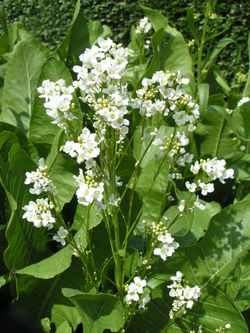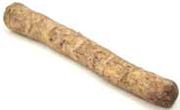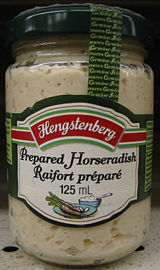Horseradish
2008/9 Schools Wikipedia Selection. Related subjects: Plants
| Horseradish | ||||||||||||||
|---|---|---|---|---|---|---|---|---|---|---|---|---|---|---|
 |
||||||||||||||
| Scientific classification | ||||||||||||||
|
||||||||||||||
| Binomial name | ||||||||||||||
| Armoracia rusticana P.G. Gaertn., B. Mey. & Scherb (1800) |
Horseradish (Armoracia rusticana, syn. Cochlearia armoracia) is a perennial plant of the Brassicaceae family, which includes mustard, wasabi, and cabbages. The plant is probably native to southeastern Europe and western Asia, but is popular around the world today. It grows up to 1.5 metres (five feet) tall and is mainly cultivated for its large white, tapered root.
The horseradish root itself has hardly any aroma. When cut or grated, however, enzymes from the damaged plant cells break down sinigrin (a glucosinolate) to produce allyl isothiocyanate ( mustard oil), which irritates the sinuses and eyes. Once grated, if not used immediately or mixed in vinegar, the root darkens and loses its pungency and becomes unpleasantly bitter when exposed to air and heat.
History
Horseradish was cultivated in antiquity. According to Greek mythology, the Delphic Oracle told Apollo that the horseradish was worth its weight in gold. Horseradish was known in Egypt in 1500 BC and has traditionally been used by Jews in Passover Seders. Cato discusses the plant in his treatises on agriculture, and a mural in Pompeii showing the plant has survived until today. Horseradish is probably the plant mentioned by Pliny the Elder in his Natural History under the name of Amoracia, and recommended by him for its medicinal qualities, and possibly the Wild Radish, or raphanos agrios of the Greeks.
Both root and leaves were used as a medicine during the Middle Ages and the root was used as a condiment on meats in Germany, Scandinavia, and Britain. It was brought to North America during Colonial times.
William Turner mentions horseradish as Red Cole in his "Herbal" ( 1551- 1568), but not as a condiment. In "The Herball, or Generall Historie of Plantes" ( 1597), John Gerard describes it under the name of raphanus rusticanus, stating that it occurs wild in several parts of England. After referring to its medicinal uses, he says: "the Horse Radish stamped with a little vinegar put thereto, is commonly used among the Germans for sauce to eate fish with and such like meates as we do mustarde."
Cultivation
Horseradish is perennial in hardiness zones 5 - 9 and can be grown as an annual in other zones, though not as successfully as in zones with both a long growing season and winter temperatures cold enough to ensure plant dormancy. After the first frost in the autumn kills the leaves, the root is dug and divided. The main root is harvested and one or more large offshoots of the main root are replanted to produce next year's crop. Horseradish left undisturbed in the garden spreads via underground shoots and can become invasive. Older roots left in the ground become woody, after which they are no longer culinarily useful, although older plants can be dug and redivided to start new plants.
Pests and Diseases
Imported cabbageworms ( Artogeia rapae) are a common caterpillar pest in horseradish. The adults are white butterflies with black spots on the forewings that are commonly seen flying around plants during the day. The caterpillars are velvety green with faint yellow stripes running lengthwise down the back and sides. Full grown caterpillars are about 1 inch in length. They move sluggishly when prodded. They overwinter in green pupal cases. Adults start appearing in gardens after the last frost and are a problem through the remainder of the growing season. There are 3 to 5 overlapping generations a year. Mature caterpillars chew large, ragged holes in the leaves leaving the large veins intact. Handpicking is an effective control strategy.
Commercial Production
Collinsville, Illinois is the self-proclaimed "Horseradish Capital of the World" and hosts an annual International Horseradish Festival each June. Collinsville produces 60% and the surrounding area of Southwestern Illinois 85% of the world's commercially grown horseradish. Other major US growing regions include Wisconsin and Northern California.
Culinary uses
Cooks use the terms 'horseradish' or 'prepared horseradish' to refer to the grated root of the horseradish plant mixed with vinegar. Prepared horseradish is white to creamy-beige in colour. It will keep for months refrigerated but eventually will start to darken, indicating it is losing flavor and should be replaced. The leaves of the plant, which while edible aren't commonly eaten, are referred to as 'horseradish greens.' Although technically a vegetable, horseradish is generally treated as a condiment or ingredient.
In the USA, prepared horseradish is commonly used as an ingredient in Bloody Mary cocktails, in cocktail sauce, as a sauce or spread on meat, chicken, and fish, and in sandwiches. The American fast-food restaurant chain Arby's uses horseradish in its "Horsey Sauce", which is provided as a regular condiment, alongside ketchup, mustard, and mayonnaise. This is not a common practice at its major competitors.
There are several manufacturers of prepared horseradish in the United States. The largest is Gold's Horseradish in New York which sells about 2.5 million jars each year. The company was founded during the 1930s by Hyman and Tillie Gold and later expanded by their three sons Morris, Manny & Herbert.
Horseradish sauce made from grated horseradish root and cream is a popular condiment in the United Kingdom. It is often served with roast beef, but can be used in a number of other dishes also.
Additionally, since real wasabi is very expensive, even in Japan, most Japanese restaurants around the world actually serve a horseradish mixture that has been dyed green. In fact, the Japanese botanical name for horseradish is seiyōwasabi (セイヨウワサビ, 西洋山葵, seiyōwasabi?), or "Western wasabi".
The enzyme horseradish peroxidase, found in the plant, is used extensively in molecular biology in antibody amplification and detection, among other things.
Horseradish sauce made from prepared horseradish and cream is a popular condiment in the United Kingdom. It is often served with roast beef, but can be used in a number of other dishes also.
In Eastern European Jewish cusine a sweetened horseradish-vinegar sauce called chrain in Yiddish traditionally accompanies gefilte fish. There are two varieties of chrain. "Red" chrain is mixed with red beet and "white" chrain contains no beet. It is also popular in Poland (under the name of chrzan), in Hungary (torma) and in Romania (hrean). Having this on the Easter table is a part of Easter tradition in Eastern Europe. A variety with red beet also exists and it is called ćwikła z chrzanem or simply ćwikła in Poland. Horseradish (often grated and mixed with cream, hardboiled eggs, or apples) is also a traditional Easter dish in Slovenia.
Horseradish dyed green is often substituted for the more expensive wasabi traditionally served with sushi, even in Japan. The Japanese botanical name for horseradish is seiyōwasabi (セイヨウワサビ, 西洋山葵 ?), or "Western wasabi".
Horseradish contains 2 glucosinolates ( sinigrin and gluconasturtiin) which are responsible for its pungent taste.
Nutritional value
Horseradish contains potassium, calcium, magnesium and phosphorus, as well as volatile oils, such as mustard oil, which is an antibiotic. Fresh, the plant contains average 79.31 mg of vitamin C per 100 g of raw horseradish .
Research applications
The enzyme horseradish peroxidase, found in the plant, is increasingly important in biochemical research fields.
Horseradish peroxidase (HRP) is commonly used for specifically coloring of thin (~5 micrometer) slices of tissue biopsies from patients suspected to have cancer. This is an area of human pathology called imuno histochemistry (IHC). Many molecules of HRP are bound to a polymer together with immunoglobulins that will bind to a primary imunoglobulin that recognizes a specific biomarker in cells in the tissue slices. The HRP will convert 3,3-diaminobenzidin (DAB) to a yellowish brown insoluble compound. This compound is visible in a microscope and helps the pathologist to diagnose the cancer. For more information see Histochemistry. Horseradish peroxidase has been employed in materials used to test for the presence of glucose in blood or urine.
Medicinal applications
Known to have diuretic properties, the roots have been used to treat various minor health problems, including urinary tract infections, bronchitis, sinus congestion, and coughs. Compounds found in horseradish have been found to kill some bacterial strains.
|
||||||||

